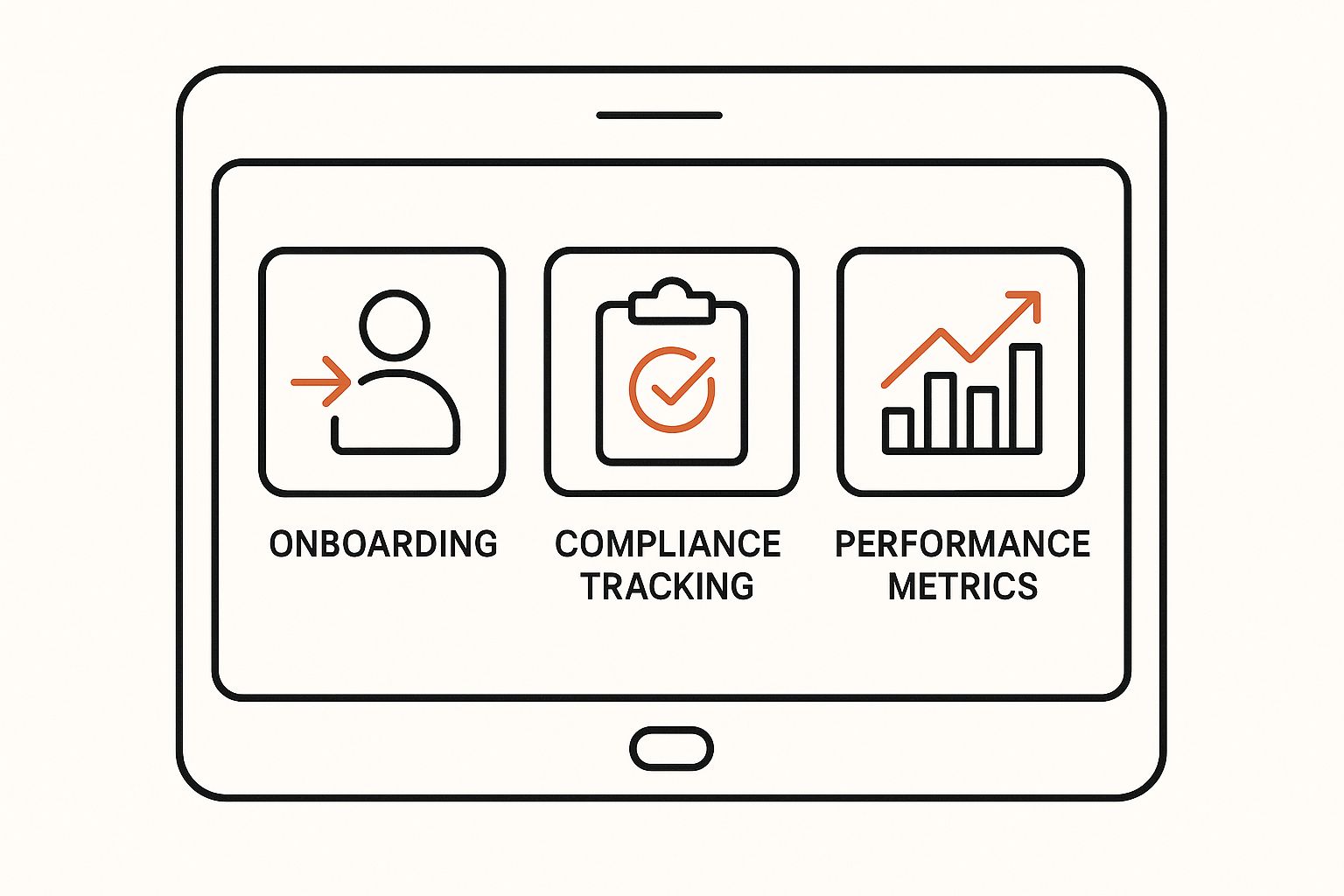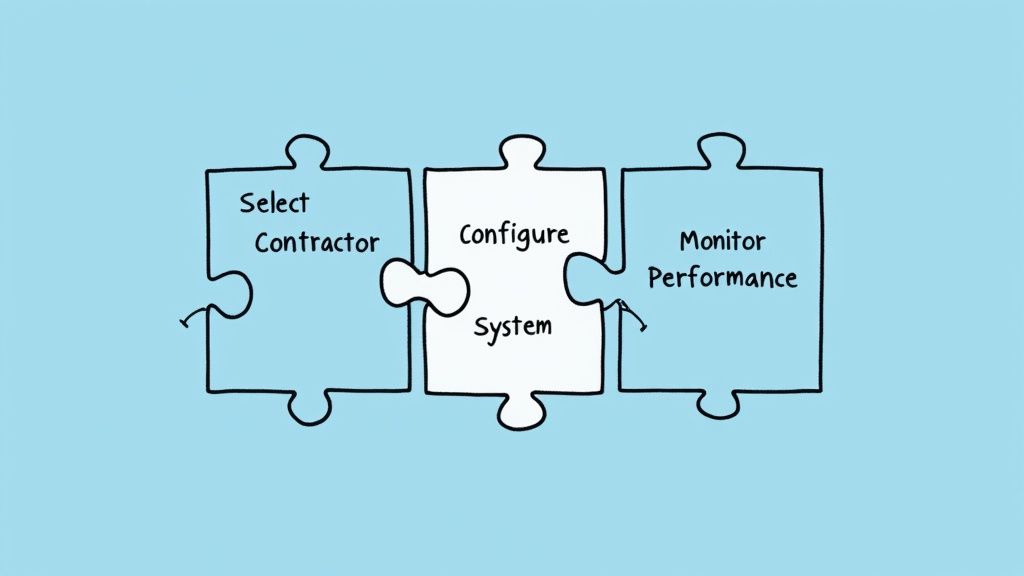Let's be honest, the term “contractor management system” sounds a bit corporate and stuffy. But let's cut through the jargon.
At its core, it's just a structured way of handling every part of working with outside contractors, from the first handshake to the final payment. Think of it like air traffic control for your worksite. It coordinates all the moving pieces to make sure nothing goes wrong.
What a Contractor Management System Actually Does
A proper contractor management system isn't just another bit of software you have to learn. It’s a complete framework that brings order to the chaos of finding, hiring, managing, and paying your external workforce.
Without one, you're probably juggling a messy combination of spreadsheets, endless email chains, and maybe even physical folders. This not only creates confusion but opens you up to some serious risks. A good system takes all those scattered bits and pieces and pulls them into one central, organised place.
This means that instead of you having to manually chase a subcontractor for an updated insurance certificate, the system automatically flags that it’s about to expire. It creates a single source of truth for everything contractor-related, which is critical for keeping projects on time and staying on the right side of safety regulations.
The Problem It Solves
Plenty of businesses, especially in sectors like construction, resources, and manufacturing, lean heavily on contractors to get the job done. But with that reliance comes a whole lot of complexity.
Every contractor brings their own set of qualifications, insurance documents, work permits, and safety history. Trying to keep track of all this manually for dozens, or even hundreds, of contractors is a recipe for disaster. It's not just inefficient; it's incredibly risky. A single missed detail, like an expired high-risk work licence, could bring a project to a screeching halt or lead to a serious incident.
The real purpose of a contractor management system is to replace that administrative chaos with organised, reliable oversight. It gives you a clear, repeatable process for every stage of a contractor's time with you.
From Onboarding to Offboarding
A good system covers the entire journey of working with a contractor, turning a complicated, admin-heavy process into a series of logical, manageable steps. This usually breaks down into a few key phases:
- Prequalification: Before a contractor even thinks about setting foot on your site, the system does the heavy lifting of verifying their credentials. This means checking for valid licences, adequate insurance coverage, and any other required certifications.
- Induction: It makes sure every single contractor completes the necessary site-specific training and fully understands your safety rules and operational procedures before they start work.
- Work Monitoring: While they’re on the job, the system helps you track their activity, monitor their compliance in real-time, and document their performance.
- Payment and Closeout: When the job is done, it helps process invoices correctly and maintains a complete digital record of all work performed. This creates a rock-solid audit trail you can rely on.
Ultimately, a contractor management system is a tool for control and visibility. It gives you the confidence that the contractors you bring on-site are qualified, compliant, and switched on to your standards from day one to the very end.
The Core Features Your Business Actually Needs
When you start digging into contractor management systems, the sheer number of features can feel a bit overwhelming. Let's be honest, you don't need every single bell and whistle. For most businesses in high-risk sectors like construction or manufacturing, a few core functions do all the heavy lifting to keep your operations running smoothly and safely.
Think of it like a toolkit. You might have a few specialised gadgets for rare jobs, but you'll always need your hammer, screwdriver, and measuring tape. It's the same deal with your management software.
To help you cut through the noise, we've broken down the essential components and what they actually do for your business.
Essential Features of a Contractor Management System
Here's a quick look at the must-have features, what they do in simple terms, and why they are so critical for keeping your sites compliant and safe.
| Feature | What It Does | Why It Matters |
|---|---|---|
| Prequalification & Onboarding | Acts as a digital gatekeeper, automatically collecting and verifying licences, insurance, and other key documents before a contractor is approved. | Prevents unqualified or uninsured workers from ever setting foot on your site, drastically reducing liability and project risks from day one. |
| Induction & Training Management | Delivers and tracks site-specific inductions, training modules, and competency quizzes for every individual contractor. | Ensures everyone gets a consistent, up-to-date safety briefing and creates a bulletproof digital record that proves they understood your rules. |
| Work Order Management | Connects approved contractors to specific jobs, outlining the scope, safety requirements (like SWMS), and necessary permits for each task. | Creates a clear line of sight between a job and the person doing it, ensuring only qualified people are assigned to the right tasks. |
| Real-Time Compliance Tracking | Continuously monitors the status of all contractor documents and flags any expired licences or insurance policies in real-time. | Moves you from reactive spot-checks to proactive compliance. The system catches issues before they become a problem on site. |
These core features work together to create a single, reliable source of truth for your entire contractor workforce.
Contractor Prequalification and Onboarding
Before any contractor steps onto your worksite, you absolutely have to know they’re qualified, competent, and insured. This is non-negotiable. The prequalification feature automates this critical first step, acting as your digital gatekeeper.
It systematically collects and verifies all the paperwork you'd normally have to chase down yourself:
- Licences and Certifications: The system checks that required trade licences, high-risk work permits, and other qualifications are valid and current. No more expired tickets slipping through the cracks.
- Insurance Policies: It confirms contractors hold the right insurance coverage, like public liability and workers' compensation, and flags any policies that are about to expire.
This isn’t just about ticking boxes. It’s about building a foundational layer of safety that stops unqualified individuals from ever starting work, protecting your project timelines and your business from serious liability. It ensures everyone, from a short-term welder to a long-term electrical crew, goes through the exact same vetting process.
A strong contractor management system transforms prequalification from a messy paper chase into a simple, automated workflow. It establishes a clear, consistent standard for every single contractor you bring on board.
Induction and Training Management
Once a contractor gets the green light, they need to understand your site, your rules, and your emergency procedures. A good system manages this entire process digitally, creating a consistent and easily auditable training record for every individual.
You can build your own custom induction modules packed with key site information, safety videos, and short quizzes to check for understanding. A digital sign-off confirms that every worker has acknowledged and understood your critical procedures before they’re even given access to the site.
The image below shows how these core functions, onboarding, compliance, and performance, all plug into a single platform.

As you can see, it’s all connected. The system links those initial checks with ongoing, day-to-day monitoring, giving you a complete picture of your contractor workforce at all times.
Work Order Management and Compliance Tracking
This is where the system really starts to earn its keep on a daily basis. The work order function connects your pre-qualified contractors to active jobs, giving them clear instructions, deadlines, and a place to upload required documents (like a Safe Work Method Statement) for each specific task.
At the same time, the system is always monitoring compliance in the background. If a contractor’s licence expires mid-project? The system sends an alert and can even block them from being assigned new tasks until their documents are updated. This real-time tracking is a game-changer for maintaining compliance without needing someone to manually check spreadsheets all day.
Let's face it, the inefficiency of manual contract administration is a massive drain on Australian businesses. Poor management practices can cause companies to lose up to 9% of their annual revenue.
Choosing a platform with these essential tools is your first step toward plugging those gaps. For a deeper look at the different options on the market, you might find our guide on the top contractor management software helpful.
Managing Compliance and Reducing Business Risk
Let’s be honest, one of the biggest reasons businesses look into a contractor management system is to get a handle on risk. When you're juggling scattered spreadsheets, overflowing filing cabinets, and manual checks, it’s not a matter of if something will slip through the cracks, but when. It's a recipe for compliance headaches.
A centralised system isn't just about tidy record-keeping; it’s about creating a single source of truth for all your legal and financial obligations. This protects your business from the very real consequences of non-compliance. We’re talking hefty fines, project shutdowns, and the kind of reputational damage that’s hard to shake.

With everything in one place, you can finally stop worrying about whether a critical document has been missed. The system proactively tracks expiry dates for everything from public liability insurance to high-risk work licences, sending you automatic alerts long before they become a problem.
Creating a Defensible Audit Trail
Picture this: a safety regulator or a major client shows up for an audit. They want to see proof that a specific electrical contractor who was on-site two months ago had a valid licence and completed the required site induction.
Without a system, that simple request kicks off a frantic scramble through old emails, disconnected folders, and stacks of paper. It’s stressful, inefficient, and doesn't exactly scream "we've got this handled."
Now, imagine the same scenario with a contractor management system. The process is completely different. You can pull up the contractor’s profile in seconds, presenting a complete, time-stamped record of their qualifications, insurance certificates, and training history. It’s all there.
This creates a bulletproof audit trail that proves you’ve done your due diligence. It shows you have a consistent, verifiable process for vetting every single contractor who sets foot on your worksite.
A contractor management system changes your compliance posture from reactive to proactive. Instead of scrambling to find proof after the fact, you have a permanent, easily accessible record that confirms your processes are sound from the start.
Protecting Your Business Legally and Financially
Beyond just acing audits, this level of organisation is a powerful tool for day-to-day risk reduction. By making sure every contractor is properly insured and qualified for the job, you dramatically lower your liability exposure.
Here’s how a system gives you practical, real-world protection:
- Prevents Uninsured Work: It can automatically block contractors with expired insurance from being assigned new jobs, closing a massive financial risk loophole.
- Verifies Licences: It confirms that people performing high-risk tasks hold the correct, current certifications required by law. No guesswork involved.
- Documents Training: It maintains a clear, indisputable record that every worker has been properly inducted into your specific site safety procedures.
Trying to manage all these moving parts manually is nearly impossible, especially as your business grows. It leaves you exposed. A system automates these crucial checks, acting as a reliable safety net.
Staying on top of different requirements across various regions adds another layer of complexity. You can learn more about the challenges of global compliance certification to see just how vital organised systems are. At the end of the day, it's about building a structured defence that protects your operations, both legally and financially.
How Australian Industries Put These Systems to Work
A contractor management system isn't just a theoretical concept; it's a practical, boots-on-the-ground tool being used every day across Australia's most demanding industries. You really see its value when you look at how different sectors use it to solve their unique problems, from keeping massive construction projects on track to navigating the complexities of public sector contracts.
The beauty of these systems is their flexibility. For a tier-one construction firm, the big focus might be on subcontractor compliance and hitting project deadlines. But for a government agency, it could be all about managing thousands of procurement contracts with total fairness and transparency.
Let's dig into how two major Australian sectors, construction and the public sector, are using these systems to get real results.
Keeping Construction Projects on Solid Ground
The construction industry is a cornerstone of the Australian economy, but it's also an incredibly complex beast. A single large-scale project can involve dozens of subcontractors, each bringing their own teams, qualifications, and machinery. Trying to coordinate all those moving parts is a massive undertaking, especially when delays are simply not an option.
This is where a contractor management system becomes the central command post for the entire site. It ensures every single subcontractor, from the crew digging the foundation to the team doing the final fit-out, has been properly vetted before they even set foot on-site.
This means verifying the essentials:
- Trade Licences: Confirming that electricians, plumbers, and other tradies hold current, valid qualifications. No exceptions.
- Insurance Coverage: Checking that every subbie has the right public liability and workers' compensation policies in place.
- Site Inductions: Making sure every worker has completed the mandatory site-specific training before their first shift.
Getting this stuff organised is non-negotiable. The Australian construction industry is forecast to hit a market size of $521.2 billion in 2025, a scale that makes relying on spreadsheets and manual checks a recipe for disaster. With ongoing supply chain headaches and rising material costs, a system that locks down contractor compliance and workflow is vital for protecting project budgets and timelines. You can find more data on the Australian construction sector on ibisworld.com.
For a site manager, the system offers a clear, real-time picture of who is on-site, what they are approved to do, and whether their credentials are all in order. That kind of oversight is fundamental to preventing costly stuff-ups and keeping the project moving.
Managing Public Sector Procurement
Government agencies and public sector organisations are up against a different kind of challenge. They're juggling a huge volume of contracts for everything from major infrastructure to IT services, often dealing with thousands of suppliers, including countless small and medium-sized enterprises (SMEs).
In this world, a contractor management system is all about ensuring fairness, transparency, and compliance on a massive scale. It gives government bodies a structured way to manage the entire procurement lifecycle, from the initial tender right through to the final contract sign-off. The system provides a clear framework for evaluating suppliers, awarding contracts, and tracking performance against the agreed-upon terms.
This is absolutely essential for maintaining public trust and making sure taxpayer money is spent responsibly. By automating the checks and keeping a clean digital trail, the system helps public sector teams confirm that all contractors meet the government's stringent standards. It takes the pain out of tracking contract milestones and payments, cutting down the administrative load while boosting accountability across the board.
A Practical Plan for a Successful Rollout
Bringing a new contractor management system into your business can feel like a huge undertaking, but it doesn't have to be a headache. A successful rollout isn't about flipping a switch and hoping for the best. It’s about a clear, practical plan that gets everyone on the same page and starts adding value right away.

The biggest mistake we see companies make is jumping straight into software demos without a clue what they actually want to fix. A solid roadmap stops confusion before it starts and makes sure your new system solves real-world problems from day one. This turns a potentially painful change into a controlled, positive step forward for your entire operation.
Define Your Goals First
Before you even think about looking at software providers, you need to know what a "win" looks like for your business. What specific pains are you trying to fix? Vague goals like "improving efficiency" are useless. You need concrete, measurable targets.
For instance, your goals could be:
- Cut the time it takes to onboard a new contractor by 50%.
- Wipe out all instances of contractors working on-site with expired insurance.
- Slash the admin time spent chasing compliance documents by 10 hours every week.
Setting clear goals like these gives you a benchmark to measure different systems against. It also makes it much easier to get buy-in from key people in your organisation because they can see exactly how it will make their lives better.
Get the Right People Involved
Choosing a system shouldn't be a decision made in an echo chamber. The people who will be using it every day absolutely need a seat at the table. Pull together a small selection team with people from different departments to ensure every angle is covered.
Your team should include someone from:
- Operations: They know the day-to-day workflow and what’s actually needed on site.
- Safety: They live and breathe compliance and risk management.
- Procurement: They manage the financial and contractual side of your contractor relationships.
This collaborative approach guarantees the contractor management system you choose works for everyone, not just one department. It also creates a group of internal champions who will help push for adoption when it’s time to go live. An integrated platform is a crucial part of an effective safety management system, tying your contractor compliance directly to your wider safety goals.
Plan a Phased Rollout
Trying to launch everything, everywhere, all at once is a surefire way to overwhelm your team and your contractors. A much smarter play is a phased rollout. Start small. Pick a single site, one department, or even just a handful of your most-used contractors.
This approach lets you iron out any wrinkles in a controlled environment. You can get real feedback, tweak your processes, and build a success story that makes everyone else in the business eager to get on board.
Once that initial group is up and running smoothly, you can systematically expand. This step-by-step process is far less disruptive and makes for a much smoother transition for everyone. It builds momentum and confidence, ensuring the new tool becomes a genuinely useful part of your operations, not just another piece of software people are forced to use.
Common Questions About Contractor Management Systems
Even with a clear plan, it's natural to have a few questions about how a contractor management system actually works day-to-day. We get it. Let's tackle some of the most common queries we hear from businesses thinking about making the switch.
What’s the Typical Cost of a Contractor Management System?
This is always a big one, but the honest answer is: it depends. The cost of a contractor management system isn't a single, off-the-shelf price. It varies quite a bit based on how the provider structures their pricing and what your business actually needs.
Most providers use one of a few common models. Some charge per user or per contractor, which means the cost scales up or down with your workforce. Others offer tiered subscriptions, where you pay a set monthly or annual fee for a specific bundle of features. The key is to find a provider with transparent pricing that fits your operational scale without trapping you in a long, complicated contract.
Can These Systems Connect with Our Existing Accounting Software?
Yes, and this is something you should absolutely insist on. A good contractor management system shouldn't operate in a silo. Its ability to integrate with the tools you already use, especially accounting software like Xero or MYOB, is crucial for a smooth workflow.
When the systems are connected, data flows automatically. Imagine a contractor’s work order gets approved in the management system, and an invoice is instantly created and pushed to your accounting platform. This completely eliminates double-handling, cuts down on human error, and massively speeds up your payment cycle. Always ask potential providers about their integration capabilities right from the start.
What Is the Biggest Mistake Companies Make During Implementation?
Hands down, the single biggest mistake is buying a new tool before defining your internal processes. So many companies get wowed by a slick software demo and assume the technology itself is the magic bullet. But if your current method for onboarding, verifying, and paying contractors is a mess, a new system will just computerise that same mess.
The most successful rollouts happen when a company first maps out its ideal workflow. Define your steps, clarify who is responsible for what, and then find a system that supports that clean, logical process.
This planning is especially critical in sectors with high-volume contractor engagement. Just look at the Australian Government, which managed 83,453 procurement contracts in the 2023-24 financial year, valued at a staggering $99.6 billion. With $11.3 billion of that going to SMEs, it highlights the immense need for robust systems to handle such diverse contractor relationships. You can find more details in these Australian government procurement statistics.
Trying to adopt a system without a solid internal framework is putting the cart before the horse.
If you're ready to move beyond spreadsheets and create a safer, more compliant workplace, see how Safety Space can help. Our platform simplifies everything from contractor onboarding to real-time compliance tracking, all in one easy-to-use system. Book a free demo today.
Ready to Transform Your Safety Management?
Discover how Safety Space can help you build a safer, more compliant workplace with our comprehensive safety management platform.
Book a Free DemoRelated Topics
Safety Space Features
Explore all the AI-powered features that make Safety Space the complete workplace safety solution.
Articles & Resources
Explore our complete collection of workplace safety articles, tools, and resources.
